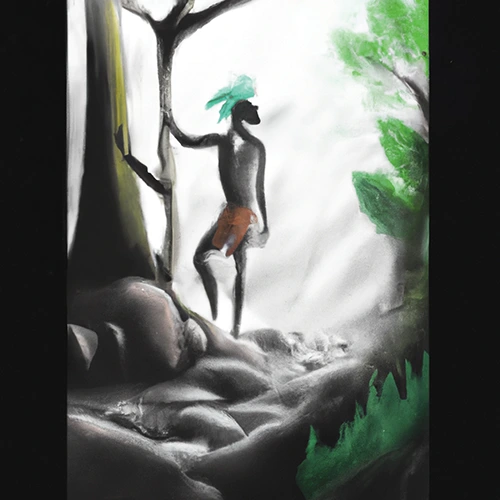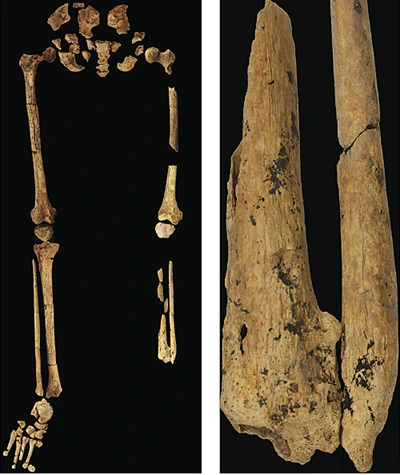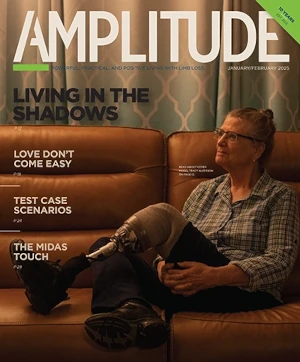By Peter Kyberd
A new archaeological find shows that prehistoric cultures knew how to provide sophisticated care for amputees—and how to reintegrate them into society.

You might have seen some news coverage last fall about a skeleton unearthed in a cave in Borneo, dating from 30,000 years ago. Its state of preservation allowed archaeologists to determine things that are usually hard to work out from remains this old—including the fact that the person had the lower part of his leg amputated. This most exciting detail indicated that ancient medical knowledge and skills were advanced far beyond the levels we have previously believed. The archaeologists could see that the amputation was carefully planned and performed, and that the patient survived for many years after the operation. They also could propose some theories about how Bornean society treated people with limb differences.
This is particularly exciting because no written records exist to tell us how ancient cultures treated people with limb differences or other disabilities. Were these individuals supported? Or were they treated as freaks or warnings to others? The Bornean remains allow us to say with more certainty how some ancient societies treated people with physical disabilities.
We can make these interpretations because the life we lead leaves its mark on our bones. Just as exercise makes our muscles get bigger, it also makes our bones get thicker and stronger. Consistent activity and repeated impact change their shape and leave marks on their surfaces. What we eat leaves a chemical signature in our teeth, and analysis of the wear patterns and calcium build-up can help us say whether the person used their teeth for holding things or just for chewing—which, in turn, can tell us whether the person was involved in food production or was important enough to just consume it. A well-preserved skeleton can tell us a lot about how a person lived, how active they were, and even what role an individual might have occupied in society.
Archaeologists are trained to reconstruct events from scant evidence, using techniques similar to those of crime-scene investigators. But prehistoric remains are rarely preserved well enough to yield clear, unambiguous conclusions. The archaeological record includes a surprisingly small number of fully intact skeletons. The majority are incomplete, with some consisting of only a few small bones. For instance, a skeleton missing a foot rarely indicates that the person lived with a limb difference. It’s far more likely the foot disappeared after burial because of natural decay, animal scavengers, soil disturbance, or some other cause.
The Borneo discovery was an extremely lucky find, providing rare insight into the history of limb difference and the development of patient care. And this specimen has offered exciting new evidence that prehistoric cultures supported people with disabilities to a far greater degree than previously understood.
Addressing Amputees’ Medical Needs
The Borneo skeleton reflects standards of limb care that were thought to be unattained until the mid-nineteenth century. It has generally been believed that amputation was an extremely unpleasant event until very recently. People have always lost limbs because of accident, trauma, and congenital factors. But deliberate amputation only occurred as a painful last resort when an infection threatened to spread from a limb throughout the body and kill the patient. The surgery had to be quick, as the pain was incredible, and the shock might prove fatal. Even then, the infection might have lethal consequences, and in the worst cases it might take down the surgeon or an assistant along with the patient. It wasn’t until the 1840s, with the discovery of bacteria, antisepsis, and anesthesia, that surgeons could operate thoughtfully and carefully, giving patients a fighting chance of survival. Only then could a prosthetics industry begin to develop and provide choices for how to cope with the challenges of limb difference.

bridged together, a healing process that takes years to occur.
The discovery in Borneo proves that this version of history isn’t entirely true, and that sophisticated limb care emerged tens of thousands of years ago. The nearly intact skeleton was laid out on its back, with the left leg terminating halfway down the shin. Why do archaeologists think the lower part of the leg was removed during life, rather than lost after burial? One reason is that the burial looks undisturbed, with no indication the bones were displaced by animals, soil, water, or other natural processes. But the definitive evidence is that the left shin shows clear signs of healing: The ends of the bone had bridged together, a slow process that takes many years to occur. From this bridge, we can be sure the person survived healthily long after the surgery, probably living another six to ten years.
We can also say with certainty that the limb loss resulted from deliberate amputation rather than trauma. The bone ends in a clean cut that suggests slow and careful removal, rather than a ragged pattern that suggests the swift hacking of a damaged limb. The cut’s location appears to have been thoughtfully chosen by someone who understood anatomy and knew how to avoid major blood vessels, which implies that the surgeon had plenty of time to consider their options—and that this was not their first amputation. Finally, there is no evidence that the bone became infected after the operation, so it is likely the care team knew how to keep the wound clean.
What did life for this patient look like after they recovered from the procedure? Here, too, the bones can tell us a lot. Just as our muscles are affected by exercise, bones also change. When I ran a marathon, I had my bone density measured the day after the race. My hip bones, which had carried me more than 50 miles a week during training, were 25 percent denser than the average person of my age, whereas my spine (which didn’t bear nearly as much of the burden of running) had the same density as a sane person who didn’t run crazy distances.
The bones of the Bornean person yield some important clues about how they lived after limb loss. Their amputated left leg is much thinner and weaker than the intact right leg, which is what we’d expect—the affected leg no longer bore weight. However, even the right leg seems less strong than usual, which suggests the person did not do much walking after limb loss. Although a large number of personal items were found at the burial location, no prosthesis or crutch was discovered. Did the person move around on the ground using their arms? A comparison of the bone density of the person’s arms might help us guess at an answer. Were they carried by friends or family members? It is hard to tell.
Whatever their mode of mobility, the person surely had significant support from others after the amputation. They must have had help in obtaining food, water, clothing, shelter, social connection, intellectual stimulation, and other needs, because they survived for roughly a decade as an amputee—and did so in comparative comfort.
The Social Role of Ancient Amputees
There are a small number of other well-preserved amputee skeletons in the archaeological record. Each provides a window into how ancient societies treated people with limb differences.
Archaeologists in Egypt have found two well-preserved mummies with absent limbs—one missing an arm, the other a foot. Each body has a placeholder limb included in their wrappings. The prosthetic foot looks worn, so this device was likely used to help the person walk. The arm is less easy to interpret. Was this prosthesis being used functionally or merely aesthetically? While this distinction is common in the modern world, it is a false choice. To some, appearance is a very important function, and it can never be dismissed as unimportant. In this case, the form-versus-function conversation must consider that burial customs in ancient Egypt revolved around preparation for the afterlife. Individuals were interred with models of goods, animals, and food they would need in the next world. From this perspective, a prosthetic limb would amount to a perfect replacement, indistinguishable from a natural limb in the hereafter—a feat that not even the most advanced modern prosthesis can accomplish. (As a maker of prosthetic limbs, this makes me very jealous.) Both mummies show that amputees in ancient Egypt were able to live well enough and acquire enough social status to merit a complex and expensive burial.
Before the discovery in Borneo, the oldest skeleton with a likely amputation was buried 7,000 years ago in France. The amputation appears to have been deliberate and not from an infection. There is no thinning of the bone, suggesting that it was an acquired rather than congenital limb difference, and the ends of the bone have healed enough that the person must have lived long after the operation. This was a very robust man who had many items buried alongside him, which usually signifies high social status. He also had osteoarthritis, which indicates that he led a very active, hard-working life. It seems unlikely he was idle or did not contribute to his community.
It is always difficult to speculate from limited evidence how amputees who lived thousands of years ago were treated. Were they accepted as peers, revered for their uniqueness, or excluded for their difference? Some scholars have suggested that societies in antiquity treated amputees as not fully human—people to mock, torture, or ostracize as a curse from the gods. I cannot see that in Borneo. This is a most careful amputation. It took time, skill, and a lot of effort. It seems highly unlikely that so many resources would be expended on a person, only to torture or neglect them afterward. It seems safe to say that this individual, like the ones from ancient Egypt and France, lived in a society that recognized the full humanity of people with disabilities and developed the capacity to care for them.
It also seems reasonable to assume that these actions were not taken solely out of charity. There probably was an expectation that, after recovering from the amputation, individuals would play useful roles to support their community. They might not be able to hunt or forage for food, but they surely could process the kill, sort the harvest, cook, make clothing, and participate in any number of other essential tasks. The French skeleton in particular shows that people could remain vigorous and play important roles in their communities after losing a limb.
Any archaeologist who assumes that amputees must have been burdens on ancient societies is making the same mistake they warn others not to: They’re discounting the ingenuity of ancient people. People from 30,000 years ago were just as intelligent as we are; they just had less sophisticated technology. But that means they were probably better at thinking for themselves and making things work with fewer resources.
The skeleton found in Borneo reflects such great skill in limb removal that it must already have been a well-developed practice, even 30,000 years ago. How much earlier did they develop this knowledge? Why wasn’t it handed down through the millennia?
As homo sapiens migrated outward from Africa, we spread to all the corners of the world—the Middle East, Europe, Asia, the Far East, Australia, and the Americas. Genetic evidence allows us to trace the direction and timing of these migrations. Sadly, Borneo sits on a side branch. The people who settled there did not go on to colonize many other places across the globe. Had they been on a more central branch of cultural expansion, they might have taken their very advanced knowledge of surgery to a far wider population than that single lucky island. If that had happened, perhaps many fewer people in history would have had to suffer trauma and death whenever amputation was necessary.
Peter Kyberd is a pioneering developer of advanced upper-limb prosthetic devices. He is the author of Making Hands: A History of Prosthetic Arms.




